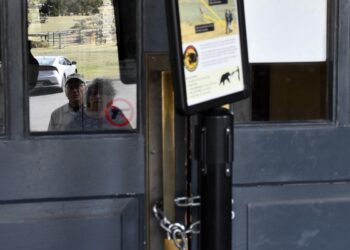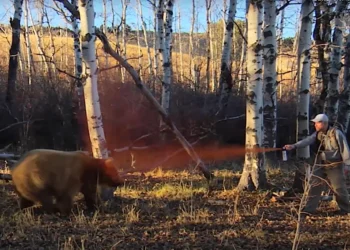Why Montana’s biologists should weigh all options before resorting to rotenone for species reintroduction
By Tyler Allen
Published: Aug. 15, 2011
The mention of Cherry Creek conjures images of
poisoned fish washing to shore and into the Madison
River late in the summer of 2010. The poisonous perpetrator
was rotenone, a piscicide capable of killing fish
in a river or lake. The chemical gained local notoriety
last fall when over 1,000 fish were accidentally killed
in Cherry Creek, a tributary to the Madison River
north of Ennis.
The cause of the fish kill was a miscalculation by state
biologists, said Travis Horton, a biologist with Montana
Fish, Wildlife
and Parks. A decision
was made not to apply
potassium permanganate
that day, a
chemical used to detoxify rotenone. The plan was to
treat the water downstream the following day, leaving
the rotenone in its toxic state. High water and resulting
low surface temperatures created conditions where
the rotenone did not degrade as soon as expected and
poisoned the stream below the intended area.
In Montana, the nonnative rainbow, brown and brook
trout, which draw fishermen from around the world,
have out-competed the native cutthroat where they
exist together. Without rotenone treatment, a stream
or lake would need to be electro-shocked exhaustively,
barriers would need to be erected, and the man-power
required would be cost-prohibitive.
Indigenous tribes use rotenone, which is derived from
tropical and sub-tropical plants, to harvest fish by
grinding the roots into a powder and spreading it on
surface water. Because rotenone is hydrophobic, it’s
usually mixed with acetone to facilitate its dispersion
in water in management applications. Fish take in the
chemical through their gills and skin, but humans
don’t absorb it well so poisoned fish can be eaten.
The westslope cutthroat trout, a sub-species of the
Yellowstone cutthroat, is Montana’s state fish and is
designated as a “Montana fish of special concern.” In
the ‘70s and ‘80s, biologists believed “a cutthroat was
a cutthroat,” so Yellowstone cutthroats were stocked
in lakes and streams that were originally home to the
westslope. Since then, hybridization and habitat loss
have drastically reduced the species’ range and population,
and pure westslope currently exist in about 4
percent of their historic range in the upper Missouri
Basin.
Since the early ‘50s, biologists from what was then
Montana Fish and Game, now called Montana Fish,
Wildlife and Parks, have used rotenone around the
state to remove nonnative fish and then stock those
streams and lakes with native trout. Unfortunately,
this treatment is poisonous to amphibians, invertebrates
and most stream-dwelling organisms.
Biologists can time treatments after larval amphibians
have emerged from the water, Horton from the FWP
said. And with such short life cycles, invertebrates recolonize
quickly after a treatment, he added.
But researchers from the USDA National Aquatic Ecosystem
Analysis Lab
found different results.
A study done after a
rotenone treatment on
the Strawberry River
in Utah found 21 percent of the invertebrate species
had not re-populated after five years.
“If there were better ways, everyone would use them.
Rotenone is a serious solution to a serious problem,”
said Peter Brown, a fisheries biologist. Brown likens rotenone
to chemotherapy: If there were a way to restore
the body or the ecosystem without bringing it to the
brink of death, biologists would do it.
Smaller lakes and streams can be harvested mechanically,
but a restored population of native fish could
be wiped out by a wildfire or landslide, negating the
restoration.
Cherry Creek, on the Madison, is a unique project in
westslope re-introduction. The watershed is large,
with multiple lakes and over 60 miles of stream in the
treatment area. The size means the system will be resilient
to natural disturbance – a fire or wind event isn’t
likely to destroy the entire population of re-introduced
fish. A waterfall near the bottom of the stream course
closes it off from natural re-population by invasive
fish.
But what if a spawning rainbow or brown is picked
up below the waterfall by an osprey and dropped
upstream in the creek? The random character of the
natural world can thwart the best of human intentions,
and biologists must consider that at length before
embarking on such ambitious and ecologically destructive
projects.
Mike Kasic, a filmmaker and biologist, applauds the
cause of restoring native cutthroat, but not at the cost
of destroying underwater ecosystems. He believes
rotenone has its place in smaller streams and lakes,
but fears fishery managers are being cavalier with its
use, acting “more like ranchers than biologists.” These
watersheds often require re-treatment to completely
eradicate the invasives, he added.
Humans are an indelible part of the Southwest Montana
landscape. In addition to the habitat destroyed as
we populate the hills and valleys, we have a significant
impact on the flora and fauna here – the introduced
European trout species now pervasive in our streams
and lakes are one example.
As stewards of the Greater Yellowstone ecosystem,
we’re faced with a philosophical question: What are
we trying to accomplish with management of these
world-class fisheries?
What conditions do we hope to restore? Forest managers
grapple with this when attempting to restore forest
systems to “historical conditions.” Do we want to
create the forest of pre-human existence? Or of pre-
European colonization, when indigenous populations
intensively managed the woodlands for wildlife and
food-bearing plants? Are we bringing the cutthroat
back because of a moral obligation to right the wrongs
of our predecessors?
Fisheries biologists brought invasive species into our
lakes and streams, and their successors must be careful
how they atone for that. Rotenone is a powerful weapon
that quickly undoes decades of poor management,
but it is a weapon being fired in a losing battle. An ecosystem
dominated by native species is more resistant to
natural or human disturbance – but Montana’s landscape
has already been disturbed dramatically. We are
trying to save a native species in an environment that is
different than the one where it evolved.
I fear we’re introducing chemicals to our streams for
aesthetic and economic purposes. Montanans want to
catch Montana fish. We want to draw anglers here with
the lure of native fish. You can catch a European trout
in rivers across this country, but cutthroat are unique.
If state biologists allow the westslope cutthroat population
to dwindle, they will end up on the Endangered
Species List, and control of their fate will be lost to the
feds. The people of Montana must manage our fisheries
with the best science available. Rotenone seems to
be the most effective means to an end, but what is that
end we hope to achieve?
Tyler Allen writes from Bozeman.













